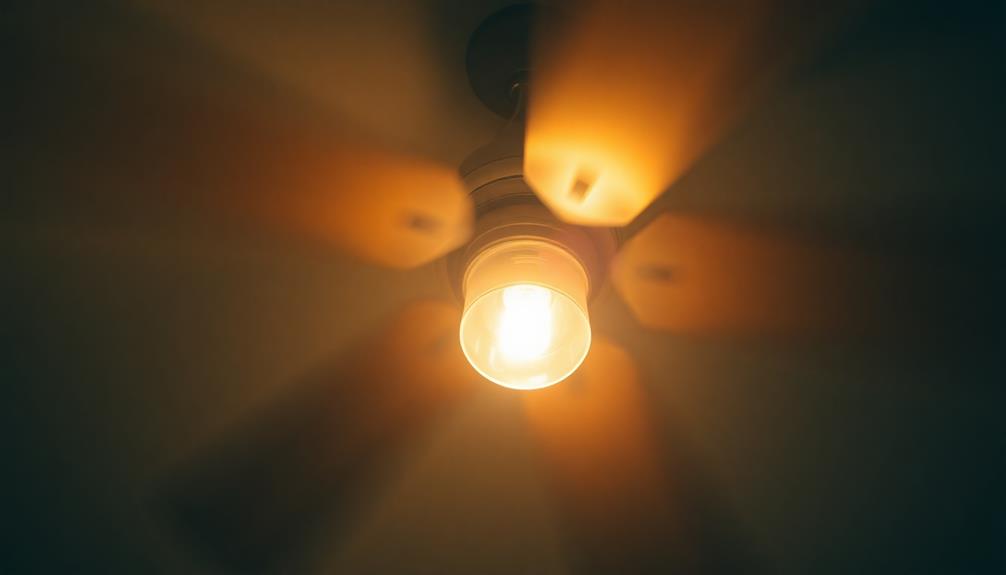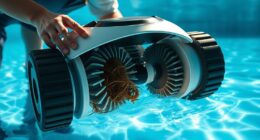To create a balanced home using Feng Shui, focus on the flow of chi. Position your main furniture against solid walls for stability and guarantee clear pathways to avoid energy blockages. In your living room, arrange seating in a circular or U-shape to encourage conversation. For bedrooms, place your bed facing the door, while desks in the home office should allow you to see the entrance. Incorporate natural materials and declutter to enhance tranquility. Personal touches like family photos elevate emotional connection. There's so much more to explore for achieving harmony in your space.
Key Takeaways
- Position furniture against solid walls to create stability and support for a balanced energy flow.
- Ensure main seating faces the entrance to promote security and a commanding presence in the room.
- Maintain clear pathways by avoiding furniture blockages, allowing chi to flow freely throughout your space.
- Incorporate natural materials and elements, such as plants, to enhance tranquility and connection with nature.
- Declutter regularly to prevent energy stagnation and maintain a harmonious living environment.
Understanding Feng Shui Principles

What if you could transform your living space into a sanctuary of balance and harmony? Understanding the principles of Feng Shui can help you achieve just that.
At its core, Feng Shui focuses on the energy flow throughout your home, known as chi. By harnessing the five elements—earth, metal, water, wood, and fire—you can foster a more harmonious environment. Incorporating elements like Indonesian decorative pillows with vibrant colors and intricate patterns can enhance this energy flow, reflecting cultural heritage while adding comfort to your space.
To create a harmonious living space, it's vital to balance Yin and Yang energies. Yin represents calming qualities, while Yang embodies vibrancy. Achieving this balance promotes overall well-being.
One effective tool in this practice is the Bagua Map, which helps you identify how different areas of your home correspond to significant life aspects like wealth and health.
Decluttering is also imperative in Feng Shui. Clutter disrupts the flow of chi and can lead to blockages that affect your mental and emotional health.
Key Furniture Placement Rules

When it comes to creating a harmonious space, following key furniture placement rules can make all the difference. Start by positioning your main furniture pieces, like sofas and beds, against solid walls. This setup provides a sense of support and stability, promoting a balanced energy flow throughout your home.
Incorporating natural materials in your decor, such as wood and stone, can further enhance this sense of grounding, creating a calming atmosphere reminiscent of Balinese design concepts. Guarantee clear pathways by avoiding any blockage of doors and walkways with furniture, allowing for smooth movement and positive energy circulation.
Next, maintain a commanding position for main seating areas by placing them to face the entrance. This arrangement fosters a welcoming atmosphere and enhances your sense of security.
Distributing weight evenly across the room is essential; balance larger furniture pieces with smaller ones to avoid energy stagnation and create harmony.
Lastly, pay attention to mirror placement. Use mirrors strategically to reflect light and positive energy, but avoid direct alignment with doors, as this disrupts the flow of chi.
Room-Specific Arrangements

Every room in your home has its own unique energy, and optimizing furniture placement for each space is essential to creating a harmonious environment.
In the living room, arrange your seating to encourage conversation. Position sofas and chairs in a circular or U-shape, ensuring there's a clear path for easy movement and positive energy flow. Incorporating elements of traditional Indonesian style home decor can enhance the ambiance with natural materials and textiles.
In your bedroom, place your bed in a commanding position against a solid wall, facing the door without being directly aligned with it. This setup promotes a sense of security and calmness.
For your home office, position your desk so you can see the entrance, enhancing focus and control over your workspace. Keep the area organized and clutter-free to maintain balance and tranquility.
In the dining room, let the dining room table be the centerpiece. Place it to allow easy movement around it, creating an inviting atmosphere for family gatherings.
In the kitchen, arrange the stove, sink, and refrigerator in a triangular layout to promote efficient energy flow, and store knives out of sight to minimize sharp energy.
Enhancing Energy Flow

Optimizing your home's energy flow starts with thoughtful furniture arrangement. To enhance the energy, arrange your furniture to create clear pathways for movement. This prevents stagnant chi (energy) and promotes a dynamic environment.
Position your main seating in a commanding position, allowing you to face the entrance. This fosters a sense of security and control over your space, vital for positive energy flow. Incorporating elements that reflect local craftsmanship can also add a unique touch to your decor, much like using traditional Indonesian wedding decor ideas to create a warm atmosphere.
Incorporating natural elements like plants and wooden furniture can further promote peace and tranquility in your home. These elements are believed to enhance positive energy flow, making your space feel more inviting.
It's also essential to maintain a clutter-free environment. Regularly organizing your spaces and avoiding overcrowding will help keep the chi flowing smoothly, as clutter disrupts energy and creates chaos.
Additionally, using mirrors strategically can amplify natural light and energy, creating a sense of openness. They can reflect and enhance the energy, further improving the overall atmosphere in your home.
Personalizing Your Space

Personalizing your space is key to enhancing the energy flow you've already established. By incorporating meaningful decor, you can create a nurturing environment that fosters a balanced atmosphere and positive energy.
Surrounding yourself with objects that hold sentimental value can deepen your emotional connection to your home. Additionally, integrating elements that reflect your personal style, such as coastal color palettes, can further enhance the ambiance and comfort of your space.
Here are three ways to personalize your space effectively:
- Incorporate Family Photos: Displaying family photos not only adds warmth but also evokes happy memories, enhancing your emotional connection to the space.
- Choose Resonant Colors and Textures: Opt for colors and textures that resonate with your personal style. A harmonious blend of these elements will create a balanced and inviting atmosphere.
- Regularly Evaluate Your Decor: As your life changes, so should your decor. Regularly reassessing your space guarantees it reflects your current preferences and maintains positive energy.
Frequently Asked Questions
How to Arrange Furniture for Good Feng Shui?
To arrange furniture for good feng shui, position larger pieces against solid walls for support, keep pathways clear, create conversational seating arrangements, use mirrors wisely, and incorporate natural elements for a harmonious environment.
How to Organize Your Home According to Feng Shui?
Organizing your home can feel like crafting a masterpiece. Start by consulting the Bagua Map, declutter regularly, position furniture for connection, incorporate the five elements, and maximize natural light to enhance your space's energy flow.
What Is the Best Layout for Feng Shui?
The best layout for feng shui places your main furniture in a commanding position, ensuring you can see the entrance. Keep pathways clear, create conversation-friendly arrangements, and prioritize comfort to enhance positive energy flow. Additionally, integrate the feng shui color rule to harmonize the energy in your space, selecting hues that align with the room’s purpose—soft blues for relaxation or energetic reds for vibrancy. Incorporate natural elements like plants or wood to further balance the environment and foster a sense of groundedness. By doing so, you’ll create a space that feels inviting, functional, and in tune with positive energy principles.
What Are the Feng Shui Rules for Couches?
As the saying goes, "Home is where the heart is." For couches, you'll want them against solid walls, creating inviting shapes, avoiding direct lines to entrances, and ensuring clear pathways for a harmonious, welcoming atmosphere.
Conclusion
Just like a well-tuned orchestra, your home needs harmony to create a beautiful symphony of energy. By embracing feng shui principles, you're not just arranging furniture; you're crafting a haven where positivity flows freely. Picture your space as a garden—each piece of furniture a vibrant flower blooming in balance. As you personalize your sanctuary, remember that even the smallest adjustments can make a world of difference, inviting joy and tranquility into your daily life.










